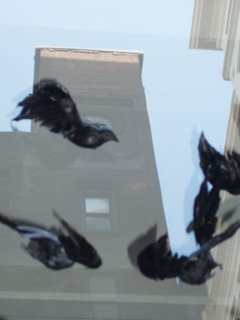What do the nation's students come up with when they go out into nature and emulate environmental artist Andy Goldsworthy? A project I'd like to do in my spare time is to compile examples of such work. One Christmas five or so years ago, the Austin Art Museum paired a Goldsworthy show (photos of a project he'd done for a wealthy family in Texas) with a Goldsworthy day at a park and also invited museumgoers to create their own earthwork arts and send in photos. It was a great way to draw the community into the museum.
What would emerge if NYC artists were asked to work with their native materials, whatever they considered them to be (okay, I'm thinking of the Goldsworthy faux-project I wrote about on this site earlier, using cigarette butts, metro cards, entrance tags from the MET, etc.) and then a show was built around their works? If Goldsworthy himself would work with "urban" materials it would be even more fascinating. Here's a recent story on student work from the Dallas News:
Students create art from nature at Arboretum
11:29 PM CST on Sunday, November 12, 2006
Their gallery was a secluded, wooded area of the Dallas Arboretum. Instead of clay or metal, they sculpted with leaves, flowers, branches and rocks.
They worked all day, creating more than a dozen pieces.

And then they left, abandoning the art for nature to reclaim.
"I prefer it that way," said student artist Laura Hall of Carrollton. "Because I know later on I won't enjoy the piece as much as the instant I made it."
Laura and 44 other students from Booker T. Washington High School for the Performing and Visual Arts participated Wednesday in an experiment.
Students enrolled in Advanced Placement 3-D design were tasked with creating site-specific art using only materials indigenous to the arboretum. Painters and photographers assisted with construction and then documented the work.
Their abstract creations hung from trees, balanced atop rock piles and sunk into the earth.
"I really liked it, getting out into nature," said junior Judge Rucker of Old East Dallas. "It helped me create pieces I thought I could never do."
The field trip culminated the students' study of the earthworks art form and artist Andy Goldsworthy, who is known for creating landscape-sensitive outdoor sculptures. Though some of these works are meant to be permanent, others last only as long as the weather conditions.
Judge said he felt no remorse about the eventual demise awaiting his sculpture of cornhusks, bamboo and flowers.
But he wonders how Mr. Goldsworthy can leave every piece he makes.
"If I did this every single day and all my pieces were like this, I wouldn't be able to do it," he said.
This was the first time the school attempted the project, which the Junior League of Dallas supported with an innovative teaching grant. Art teacher Paige Furr said they hope to make it an annual outing.
"It's a creative problem-solving experiment," she said. "It's an assignment that colleges do a lot. And they are doing work of a college level."
Once arboretum officials understood that the students had no plans to cut flowers in the garden, they got excited about the partnership, said Amy Winkelmeyer, who works in the arboretum's education program.
"It's fascinating," she said. "I was over there several times today. I'm just amazed at the ability and imagination they have to have to even come up with the ideas."
Senior Amber Campagna of Old East Dallas said she felt intrigued by the concept of making art from materials that surround her every day.
"It's not a piece of artwork that you can sell," she said. "It's something you just create for people to enjoy."
Leaving the art to nature makes creating it more interesting, said senior Alex Hamrick of Old East Dallas.
"It changes the sculpture but it doesn't change the quality," he said. "You can't take it out of the environment, so that makes it easier to let go. But if we hadn't gotten pictures of it, and I knew right now it was being washed away, I'd be thinking 'Oh, no.' "
Junior Suzanna Weeks of Old East Dallas, a painter, was intrigued by the idea of art abandonment.
"In a way, it must be really freeing to do a piece and leave it," she said. "When I do paintings, I come back later and say, 'I should have done this or that.' "
The students worked in an area off-limits to arboretum visitors. But they plan to exhibit the drawings and photos in the spring at school and next fall at ArtScape, the arboretum's fine arts show and sale.
Arboretum officials call the garden a living museum. ArtScape, held for the first time in September, draws on the link between nature and art, Ms. Winkelmeyer said.
The student project solidifies the connection, she said.
"It's a perfect marriage and it was an accident," she said. "They didn't even know we had an art show."
--end--



